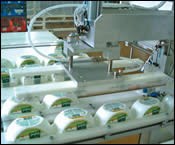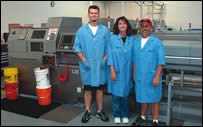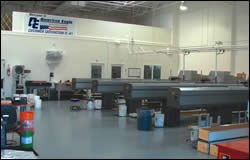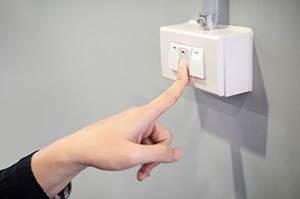The New American Night Shift
Strong customer service is what has made this company successful. However, while keeping the customer happy is a primary goal for American Eagle, it is the customer service it has received that has made the biggest difference. Now, increased lights-out operations are allowing the company to be even more competitive by providing lower shop rates for the customer.
Jim Lamatrice, president of American Eagle (Las Vegas, Nevada), was accurate in his vision that he’d be making his fortune at night, but the details of how it would happen did not quite fall into place the way he expected. He started his business as a Davenport shop in 1988 in Phoenix, Arizona, and then moved to El Paso, Texas, and eventually settled in Las Vegas. The company served the cable television market exclusively and lived and died by the condition of its primary customer.
By the mid 1990s, business was declining drastically, so Jim decided to close shop, sell all of the equipment and move on to bigger and better things. He knew there were other opportunities out there, and he wanted to achieve his dreams. For temporary income, he drove a concrete truck, but his goal was to own a restaurant and bar. He knew the income potential for such a business in the Vegas area was outstanding, so he quickly set his sites on that industry and became a bartender.
One night, while working late at the bar, gunmen stormed in the front and back entrances. One of the men grabbed Jim from behind, held a gun to his head and demanded that he open the safe. While the attackers were in the building, two of Jim’s customers attempted to escape. Both customers were shot, and one died from his wounds. This life-changing experience was enough to drive Jim out of the restaurant business and back to precision machined parts.
Back To Business
By 1998, he was back in business as a machine shop owner. He bought a relatively low-cost machine and set it up in his garage. Although the machine would not run untended and Jim had a few problems with it, it got the work done and his business grew quickly. Within a year, Jim decided to move into an 800-square-foot facility and buy a second machine, a top-of-the-line slant bed lathe, from the same company. This time, he wasn’t so lucky.
When the new machine came in, it was inoperable. The Z-axis motor was not even hooked up to the ballscrew; Jim was not able to run a single part on the machine. He placed more than 30 calls to the company before a service rep came out. He could not keep up with his workload and ended up farming out the work and losing the profits.
After some negotiations, the manufacturer offered to take both of the machines back, refurbish them and sell them, giving Jim the proceeds to put towards his loans. However, once the machines left Jim’s floor, the problems really began. The manufacturer refurbished the machines and sold them, but never turned the money over to Jim. By the time his attorneys were able to win judgement in court, the manufacturer had gone bankrupt and was not required to pay. Jim still owed the notes on the machines and had nothing to show for them.
The Tables Turn
Finally, in 2000, Jim’s luck started to change. He attended IMTS that year and was introduced to the people at Marubeni Citizen-Cincom (MCC) of Allendale, New Jersey. Jim says, “When I got to the booth, the sales people were so fired up, and a group of Citizen users were there as well, sharing their success stories.” Jim spotted an L-20 Swiss turning center that looked like the perfect machine for his shop. The seven-axis lathe offers cross spindle options that allow as many as 21 tools and front and back end-face drilling capabilities. Unfortunately, the price was higher than he could afford at the time, given his outstanding debts. Beyond that, MCC did not have any of the machines in stock, and it would be at least 4 months before they could deliver one to him. Jim was in a desperate situation as his work piled up. He knew he’d be out of business by the time he could get his hands on an L-20.
Shortly after the show, during a meeting with MCC and Spinetti Machinery (the local distributor), Jim was informed that an L-25 was available on a showroom floor in Huntington Beach, California. To his amazement, MCC loaned him the machine, paid for the freight to his shop, set it up and sent someone to his shop to train him. He used the machine for 6 months at no charge, until MCC was able to deliver a new L-20. At that point, Jim had made enough money to pay off his existing loans and begin paying on his new machine.
Since that time, Jim has purchased a total of eight L-20 machines, about one every 6 months. He currently has five L-Series machines on his floor, the oldest only 2 years old. The company has a couple of machines dedicated to specific parts. The other three machines juggle the rest of the workload. Typical setup times run between 1 and 4 hours. He does such strong business with the machines that he’s able to pay one off before he brings in the next. Financing the machines is easy now. He has built such a foundation for his business at this point that the loans are almost automatic. He places machinery orders with confidence that delivery and setup will be quick, and the machines will be making parts by the time he makes his first payment.
Gaining Momentum
As the business has grown, American Eagle has also moved into larger facilities. The company moved to a location with 2,100 square feet, and then in February 2006, purchased a building with 4,500 square feet. It is an extremely clean facility, and Jim keeps the machines immaculate. The floors were professionally sealed by a cement company to make cleanup easier. Because of the more organized operations, and the incorporation of some lean processes to increase efficiency, Jim says they see so much better productivity as well. The company now has only three employees, and they are working fewer hours than ever before. However, the bottom line shows 50-percent growth for 2006, with more than $1.4 million in sales.
At American Eagle, the goal is to be at the shop as little as possible, while keeping the machines running continuously. The majority of the workpieces run are custom hardware components used inside slot machines. Most of these parts are machined in 12L14 steel, with some 303 stainless, brass and aluminum, and the company uses some ground stock. These materials lend themselves nicely to the lights-out operations. Jim says, “We would not be able to run untended like we do if we were running 416 or Inconel, but given the jobs we run, with the use of automatic bar loaders, we can pretty much let the machines go.”
Another key to the untended operations, as Jim points out, is the tooling. “Each evening we check all the tooling to make sure it is fresh,” he says. “We use statistical process control to log how much has been cut and to project how far through the night each machine will get. We have monitors on each machine, so if a tool happens to break, an autodialer alerts me by phone to let me know which machine is down. Then I can decide whether or not to come in to fix the problem. Each morning, then, we recheck all the tooling and processes to be sure all ran smoothly.”
At this point, Jim is transitioning his shop to Citizen’s newer L-720 machines. These machines offer the Mitsubishi Meldas 700LC control, full servo axes and two independent tool posts, allowing a 40-percent reduction of non-cutting time compared to the previous L-20 machines. He put the first of these machines on his floor in June 2006, and he knew almost immediately they could take him to the next level. He asked Spinetti Machinery to sell his older machines and replace them with the newer models. Jim says, “The other machines have been operating fine, but the newer ones are that much better. I run parts on the L-720—same programs, same jobs—and I make $5 to $10 more an hour. That might not sound like much, but when I have four machines working 20 hours a day, 7 days a week, it turns into a lot of money. I especially can’t go wrong when you consider I sold my first L-20 for about 85 percent of what I paid for it 3 years ago.”
Teamwork Pays Off
Jim feels that he owes a large part of his success to MCC and, just as important, the relationship he has built with the Spinetti Machinery team. Jim says, “We’ve done projects together that have taken me where I want to be. I’m now a loyal Citizen user because of what they’ve done to help me.” He has worked with Spinetti Machinery to develop some innovative techniques that he feels are unique enough to put him far ahead of his competition. “We’re doing stuff on the Citizens that other people just don’t do. We run extrusions, using the machine kind of like a mill sometimes.” They were able to develop a way to handle the barstock, and now, parts that used to require three or four operations on the mill can be dropped off complete on the Citizen.
Jim maintains his goal of as much lights-out production as possible. He works to continually improve the processes with better oils and inserts. He bought an automated tumbler at IMTS 2006, and he has a parts washer on order. He recently added chip augers and chip conveyors to each machine. “Increased automation translates into less man-hours,” Jim says. “We don’t even turn the machines off anymore, except to change tools. We’re trying to get our time at the shop down to 4 or 5 hours a day, 4 days a week.” At that point, Jim will truly reap the rewards of the night shift.
Related Content
Tips for Troubleshooting and Repairing Chip Conveyors
A nonfunctioning chip conveyor can cause a high-production machine to be down for an extended period of time. Here is some troubleshooting advice if you’re having issues with your chip conveyors.
Read More4 Bright Ideas for Effective Lights-Out Machining
Adopting lights-out machining involves considerations when a machine shop decides to move forward with the process. Here are some tips to a successful implementation.
Read MoreReinventing the Wheel with Robot-Automated CNC Multitasking
One race team discovers how to efficiently manufacture a new wheel nut design for the next-generation NASCAR stock car with the help of a CNC mill/turn and a built-in robot.
Read MoreStarting Small with Automation
Quick-change workholding and flexible robotic automation started this small shop on the path to success.
Read MoreRead Next
Lights-Out Machining Boosts Turning Capacity
A Colchester Tornado A50 CNC lathe, equipped with a bar feed, Renishaw probing, tool monitoring, pickoff unit, swarf conveyor and production-scheduling software, is providing lights-out production capability for Altex Engineering, a (Calne, Wiltshire) U.K. precision subcontractor that specializes in turning and milling in addition to sheet metal fabrication using laser cutting, punch press and folding equipment. With the new CNC lathe, Altex has increased productivity by more than 50 percent on a range of turned components, some 80 percent of which are now completely machined in a single setup.
Read MoreBar Feed Considerations For High-Speed, Lights-Out Machining
There are design elements incorporated into today’s 12-foot, magazine-load bar feeders that make them more useful for high-speed and untended operation. This article looks at some aspects to consider before purchasing a 12-foot bar feeder.
Read MoreSeeing Automated Workpiece Measurement in Real Time
User-friendly inspection software for CNC machining centers was shown at IMTS 2024 monitoring measurements between and after machining while performing SPC based on recorded measurement values.
Read More


















.jpg;maxWidth=300;quality=90)







